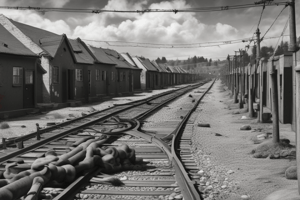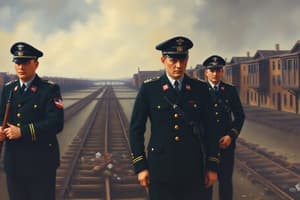Podcast
Questions and Answers
What was the primary purpose of the SS subjecting individuals to the experiences within Nazi concentration camps?
What was the primary purpose of the SS subjecting individuals to the experiences within Nazi concentration camps?
- To provide labor for the war effort while maintaining a semblance of order and discipline.
- To instill fear and rob individuals of their humanity. (correct)
- To offer re-education and assimilation into Nazi ideology.
- To provide a controlled environment for medical experiments on unwilling participants.
Which of the following was NOT a common reason for individuals being captured and sent to Nazi concentration camps?
Which of the following was NOT a common reason for individuals being captured and sent to Nazi concentration camps?
- Active opposition to the Nazi regime.
- Being of Jewish descent.
- Membership in a rival political party.
- Having physical disabilities. (correct)
What contributed to the lethal conditions during transportation to concentration camps?
What contributed to the lethal conditions during transportation to concentration camps?
- Overcrowding, lack of food and water, and unsanitary conditions. (correct)
- Luxurious accommodations and sufficient rations, which were intentionally poisoned.
- Guards providing medical care for the ill with experimental medicine that often had fatal side effects.
- Open-air transport to expose prisoners to harsh weather conditions, causing illness.
Upon arrival at a concentration camp, what was the immediate process that determined a prisoner's fate?
Upon arrival at a concentration camp, what was the immediate process that determined a prisoner's fate?
Which of the following actions best exemplifies the dehumanization process within Nazi concentration camps?
Which of the following actions best exemplifies the dehumanization process within Nazi concentration camps?
What role did 'Kapos' play within the concentration camp hierarchy?
What role did 'Kapos' play within the concentration camp hierarchy?
What was a main contributor to the spread of disease within concentration camps?
What was a main contributor to the spread of disease within concentration camps?
What was the purpose of 'Appell' in the daily routine of concentration camp prisoners?
What was the purpose of 'Appell' in the daily routine of concentration camp prisoners?
Why was it so dangerous for prisoners to die during the night?
Why was it so dangerous for prisoners to die during the night?
Blockfuehrers, distinguishable by their green triangles, what power did that mean they possessed?
Blockfuehrers, distinguishable by their green triangles, what power did that mean they possessed?
Beyond physical ailment, what was primarily lacking in the sick bays and infirmaries?
Beyond physical ailment, what was primarily lacking in the sick bays and infirmaries?
Despite facing horrific conditions, what actions demonstrated prisoners' efforts to maintain their humanity?
Despite facing horrific conditions, what actions demonstrated prisoners' efforts to maintain their humanity?
What was the immediate impact of liberation on concentration camp survivors?
What was the immediate impact of liberation on concentration camp survivors?
What broader lesson does the Holocaust teach future generations?
What broader lesson does the Holocaust teach future generations?
Post-liberation, what was a significant challenge faced by Holocaust survivors?
Post-liberation, what was a significant challenge faced by Holocaust survivors?
What characterized the daily food rations provided to concentration camp prisoners?
What characterized the daily food rations provided to concentration camp prisoners?
What action best illustrates resistance against the dehumanizing conditions of concentration camps?
What action best illustrates resistance against the dehumanizing conditions of concentration camps?
What factors contributed to the spread of typhus and tuberculosis within concentration camps?
What factors contributed to the spread of typhus and tuberculosis within concentration camps?
What was the immediate goal of dehumanization of prisoners upon entering the camps?
What was the immediate goal of dehumanization of prisoners upon entering the camps?
What conditions exemplify the severe overcrowding in concentration camp barracks?
What conditions exemplify the severe overcrowding in concentration camp barracks?
Flashcards
Reasons for Capture
Reasons for Capture
Arrested for opposing Nazis, being Jewish, or deemed undesirable.
Camp Transportation
Camp Transportation
Overcrowded, unsanitary, and terrifying journeys to concentration camps.
Arrival and Selection
Arrival and Selection
Division into groups and assessment for work or immediate execution.
Dehumanization Process
Dehumanization Process
Signup and view all the flashcards
Kapos
Kapos
Signup and view all the flashcards
Camp Badges
Camp Badges
Signup and view all the flashcards
Meager camp rations
Meager camp rations
Signup and view all the flashcards
Appell
Appell
Signup and view all the flashcards
Maintaining Hope
Maintaining Hope
Signup and view all the flashcards
Liberation
Liberation
Signup and view all the flashcards
Study Notes
- The experience of being captured by the SS and sent to a Nazi concentration camp was designed to rob individuals of their humanity and instill fear.
Capture
- Capture could occur due to opposition to the Nazis, being deemed undesirable, random mass arrests, religious beliefs, or being Jewish.
- The journey involved being forcefully loaded into vehicles without food, water, or toilet facilities.
- The conditions were overcrowded, filled with the smells of vomit and excrement, and instilled constant anxiety.
- Family members could be lost during transit, with no hope of ever seeing them again.
- The destination was kept secret, adding to the terror and uncertainty.
Transportation
- Transport conditions were often lethal due to inhumane conditions.
- Many prisoners died en route from dehydration, starvation, suffocation, or illness.
Arrival and Selection
- Upon arrival, prisoners were divided into groups of men and women with children.
- Prisoners were subjected to a macabre welcome where they were asked to provide their age, occupation, and health condition.
- Based on the answers given to SS officers, prisoners were deemed for work or immediate execution.
- Those deemed unfit for work were sent to gas chambers, with no means of escape.
Dehumanization
- All belongings were confiscated with no chance of return.
- Prisoners were registered and assigned a prison number to erase individual identities.
- At Auschwitz, prisoners had the number tattooed on their arms.
- Prisoners then had their heads shaved and were forced to shower in groups under scrutiny.
Camp Hierarchy and Living Conditions
- Strict structure mimicked the model established at Dachau.
- The German staff was led by the Lagerkommandant, junior officers, and male and female wardens.
- Prisoners had their own hierarchy with prisoner-supervisors or Kapos.
- Prisoners were assigned colored triangle badges designating placement and task assignment.
- Barracks were designed to hold far fewer people than those crammed inside, leading to miserable living situations.
- Bunks were tiny and often shared by multiple prisoners (up to 6 per tier).
- Sanitation facilities were inadequate, leading to overflowing toilets and the spread of the disease.
- Straw mattresses were rarely replaced, which caused infestations.
Health and Hunger
- Meager food rations: Watery soup, stale bread, and occasionally a small piece of sausage or cheese.
- The struggle for even the smallest scraps of food became a daily trial.
- Prisoners would face heavy construction, rock quarrying, digging trenches, or factory work.
- Prisoners faced 14 hours of work per day while being watched by guards.
- Beatings by supervisors, death from overwork, and use as medical experiment subjects were risks.
- There was no medical attention, minor injuries festered, and illnesses such as typhus and tuberculosis spread.
Daily Routine
- Appell, or daily lineup, took place every morning and evening in all weather conditions.
- Prisoners woke up between 4am and 4:30am to a gong and yelling.
- Bodies of those who died overnight were ignored by German officers.
- Failure to make this bed will result in death, and is known as "bettenbau"
- Breakfast of stale bread with coffee or tea.
- During The Appel, prisoners stood in rigid rows and were counted.
- Movement was met with swift and brutal punishment.
- Attempts to evade were met with beatings, torture, or death.
- Prisoners were marched off to work sites and sung degrading songs for the guards' amusement.
- Afternoon roll call and a small lunch offered before continuing grueling work.
End of Workday and Camp Life
- Prisoners are marched back to camp for the final roll call after work.
- Those who died during the day are carried back by fellow prisoners for the evening roll call.
- Inaccurate counts of prisoners made roll call take hours.
- The roll call process could be intentionally lengthened as a form of punishment.
- Prisoners who survived the day without collapsing or facing punishment receive a meager dinner ration, often thin vegetable soup.
- In some camps, dinner was a luxury, and prisoners went straight to the barracks after work.
- Free time in the barracks involves bartering among prisoners.
- Prisoners must return to their barracks after dinner.
- Lights out is typically by 9 pm, with strict prohibitions against leaving the barracks at night.
- Blockfuehrers, also called Death Heads, patrol the grounds to prevent prisoners from sneaking out.
- Blockfuehrers wore green triangles, indicating they were "real criminals" with the power to determine life or death.
- Returning to the barracks meant surviving another day, but also facing the same ordeals the next day.
Healthcare and Sickness
- A lack of medical facilities meant that sickness often led to death.
- Sick bays or infirmaries were illusions of care.
- In some camps, fellow inmates ran sick bays but were overwhelmed by diseases, conditions, and shortages.
- Diaries from Holocaust survivors detail experiences in concentration camp infirmaries.
- Infirmaries lacked water, plumbing, and electricity, relying on natural lighting.
- They contained dirty cots and straw mattresses covered in pus and blood.
- Mattresses were shared by at least two sick individuals, often skeletal, covered in scabies, lice, or naked.
- During disease outbreaks, more than two sick people shared a mattress.
- The sick shivered from cold, suffering, and waited for help or death.
Maintaining Hope and Humanity
- Despite conditions, prisoners held onto hope.
- Attempted to maintain cultural and religious activities.
- Some kept journals and diaries detailing their experiences.
- Others created artwork depicting life in the concentration camps.
- Some prisoners produced jewelry out of copper wire.
- These works serve as testimonials to life in concentration camps.
- Acts of defiance kept spirits alive and humanity intact amidst despair.
The Reality of Daily Life & Liberation
- Life in Nazi concentration camps was a routine nightmare.
- Prisoners were stripped of basic rights and possessions.
- Daily life was marked by brutality, dehumanizing routines, and constant fear.
- Prisoners displayed remarkable strength and humanity despite the horrors.
- Artworks and writings retained shreds of identity and humanity.
- These stories serve as a reminder of the human spirit's ability to endure.
- Prisoners endured until rescued by Allied forces.
- Liberation marked the end of a chapter filled with cruelty, loss, and trauma.
- Liberation offered a glimmer of hope for a better life.
- It did not erase the scars from the minds of those affected.
Post-Liberation
- Following liberation, survivors faced the challenge of rebuilding their lives.
- They grappled with trauma and sought justice for the atrocities.
- The Holocaust serves as a reminder of the consequences of hatred and inhumanity.
- Future generations are urged to remember the past and prevent such horrors.
- People need seek leadership that works for the freedom and safety of the innocent.
Studying That Suits You
Use AI to generate personalized quizzes and flashcards to suit your learning preferences.




